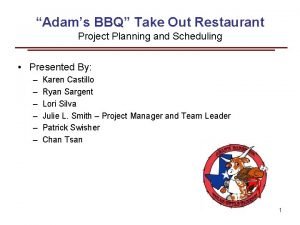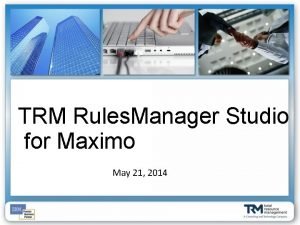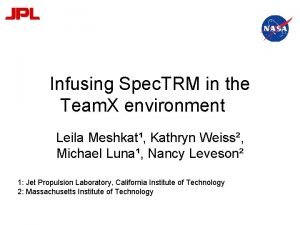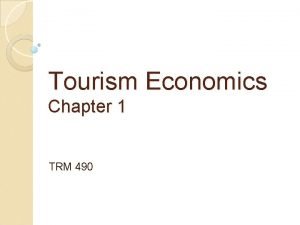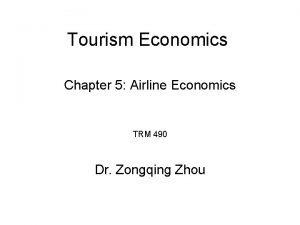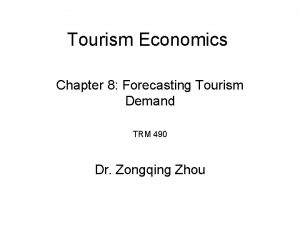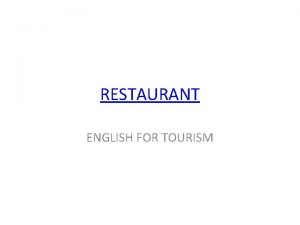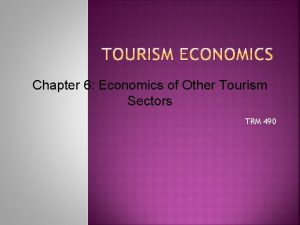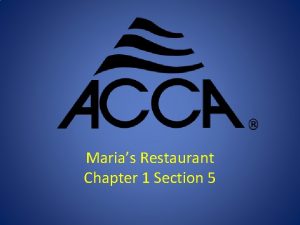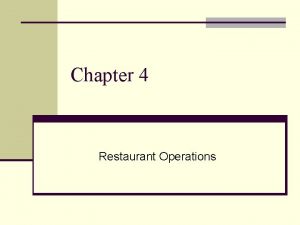Tourism Economics Chapter 4 Restaurant Economics TRM 490

















- Slides: 17

Tourism Economics Chapter 4: Restaurant Economics TRM 490 Dr. Zongqing Zhou

Introduction Overview Restaurant depends heavily on tourists for sales. Expansion abroad is the trend Restaurant chains dominate the restaurant sales (about 47% of the sales) Today's restaurant industry employs 14. 4 million Americans in 1 million+ locations Sales for 2016 are expected to reach $782. 7 billion http: //www. restaurant. org/News-Research/Facts-at-a-Glance http: //www. restaurant. org/research/forecast/

Quick glance 2016

Types of Restaurants Classification of restaurants Fast food chains (Mc. Donald’s, Burger King, Subway) Pizza take-outs (can be part of the fast food chains) Others Family restaurants Offer waiter/waitress service and often self service salad bars, breakfast bars and dessert bars Most food is cooked to order or made from frozen or chilled prepared foods Dinner houses Provide lunch and dinner Feature ethnic cuisine such as Mexican or Italian. Fine dining restaurants Under 100 seats. Depend on attracting people in the public eye. Wine sales help keep high check average and low beverage cost. Casual dining Relate more to colorful décor, laid-back service and heavy marketing.

Fast Food Restaurants Fast food restaurants: $191 billion sales in 2013 in 232, 611 establishments* The big fortunes in the food service business have been made in fastfood. Mc. Donald’s is a “built-on” system which is a system for doing everything: High profile advertising Low labor costs (30% of the sales) Standardization (purchasing and portion control) * http: //www. statista. com/topics/863/fast-food/

Franchisees Pay initial franchise fee and continuing royalty fees that include advertising assessments, equipment purchase, and rent. Chains are on-line by computer, or report sales and other operating figures every night. Linking computers between in-store and corporate offices allows managers to complete time-consuming chores more efficiently. New franchisees take pre-opening training, franchisor helps with site selection and provides operational manuals and troubleshooters. Rely on teenagers, twenty year olds and immigrants as employees Low wages, high turnover rate, and few pay raises keep labor costs down Extremely efficient in the use of labor Depend on catchy slogans and TV advertisement Able to negotiate purchasing advantages due to size Are sometimes able to use mass purchasing to decrease costs

Product Standardization Exact standards for buying, processing, preparing and serving. Carefully specified menu items. Preparation methods are controlled by training and selected equipment. “Cookie cutter” approach to building and operating franchised unit reduces costs and controls quality. Units are distributed with good locations and other optimum conditions.

Economies of Scale and Mass Marketing Large franchisor can assure the franchisee of reduced costs in everything from building blueprints to the cost of a pat of butter. Economies of scale carry over to mass marketing and merchandising, which is critical in meeting the competition with the best advertising firms, TV advertising, and imaginative promotional schemes.

Technology and Efficiency Technology in the franchising management: Manually in the old days, the old pencil and paper. Network today: computers are linked from the franchisors to the franchisees for sales reports and other operating figures. Tables offer portable terminals in an effort to keep labor costs lower. Restaurants now have applications for smartphones that make ordering even easier. Efficiency in fast food chains Profit before income taxes for a quick service restaurant is 8. 2%, whereas a table-service restaurant is 3. 2%. Competition to the fast food chains Food at home Factors: gas, time, health, taste, food cost at home Other kinds of restaurants Convenient stores and supermarkets

High Risk of Failure High failure rate Reasons Too many restaurants (supply outpaces demand) Easy entry Owners are typically not well-educated and know how to manage 27% fail during the first year 50% at the end of three years 60% by the end of five years Many new restaurants fail because they lack a financial cushion to carry them through the several months needed to gain consistent profitability.

Economic Measures in Restaurant Operations Economic measures in restaurant operation Prime costs Food Labor Profitability: keep the prime cost below 60 -65 percent of sales. Cost Mixes that could be profitable: Steakhouse: 40% food cost / 20% labor cost Family Restaurant: 33% food cost / 30% labor cost Luxury Restaurant: 35% food cost / 30% labor cost Mexican Restaurant: 28% food cost / 28% labor cost Fast-food Hamburger Restaurant: 30% food cost / 25% labor cost For restaurants with heavy bar sales, the cost mix may be different.

Breakeven Analysis Estimation of the sales volume needed to break even and the profit that can be made at various levels of sales Various types of costs include: Food cost as a percentage of food sales Beverage cost as percentage of beverage sales Product cost, total f&b cost as a percentage of total f&b sales Payroll and related cost, including employee benefits Prime cost, total product and labor cost Other operating costs Occupancy and capital cost

Breakeven Chart Fixed cost: not changed with sales Variable cost: changed with sales Semi-variable cost: partially fixed, partially variable

Seat Turnover Seat Turnover: the number of times a table is reoccupied by a customer It is a widely used measure for the restaurant operator. Could be as high as seven times during the rush lunch hour and as low as once or twice an evening in a luxury restaurant. Serving speed correlates with check average, menu selection, employee training, kitchen personnel, layout, service style and customer type Maximize sales incomes and concentrate on sales that produce the highest profit The fast-food operator wants the customer in, served and out as soon as possible The luxury restaurant, on the other hand, wants the customer to linger, select expensive wine and order a complete meal.

Employee Theft Widespread Tight cost controls, especially on bartenders. Keep close tabs on cost percentages, variance of one or a few points from a standard can indicate a problem and corrective measures should be taken.

Forecasting Restaurant Sales Forecasting restaurant sales Plots sales using past experience, and estimates sales for the week ahead and season Table service restaurants high on weekend; as high as account for one-half of all weekly sales. Forecast are compared with actual sales and variances from forecasts examined Purpose of sale forecast For food purchasing Labor scheduling Revenue control Marketing

Restaurant Finance Larger restaurant chains raise capital through stock sales Independent operator gets funds wherever possible. Restaurant buildings and equipment are more often leased than purchased. Financial winners have been chains with regional and national marketing clout and programs for purchasing, controlling costs and training personnel.
 Scope of restaurant project
Scope of restaurant project Mass tourism vs alternative tourism
Mass tourism vs alternative tourism Maximo test usability
Maximo test usability Exame trmtb
Exame trmtb Iiirm togaf
Iiirm togaf Trm
Trm Mas trm guidelines 2021 checklist
Mas trm guidelines 2021 checklist Travel risk management maturity model
Travel risk management maturity model Trm
Trm Togaf resource base
Togaf resource base Trm rules manager
Trm rules manager Trm np
Trm np Trm anh
Trm anh Four t's of risk management
Four t's of risk management Antzi_ts
Antzi_ts Dari 60 orang siswa ternyata 36 orang gemar membaca
Dari 60 orang siswa ternyata 36 orang gemar membaca Makanan yang disediakan pengusaha
Makanan yang disediakan pengusaha Harga saham di bej mempunyai nilai tengah 490 7
Harga saham di bej mempunyai nilai tengah 490 7
